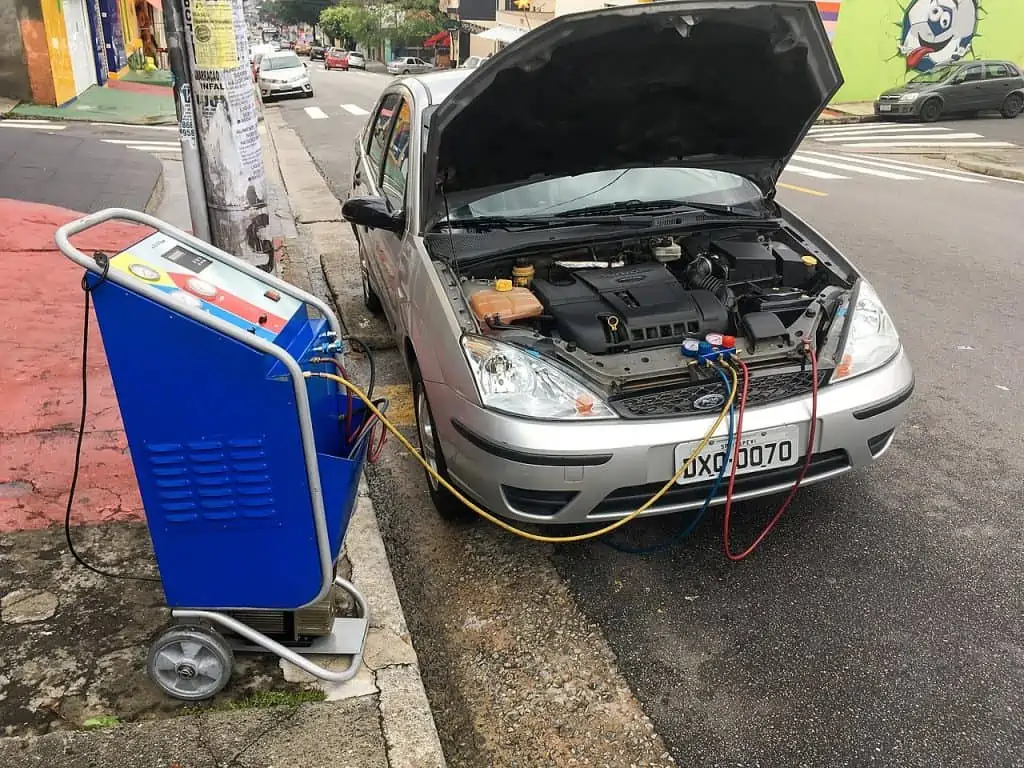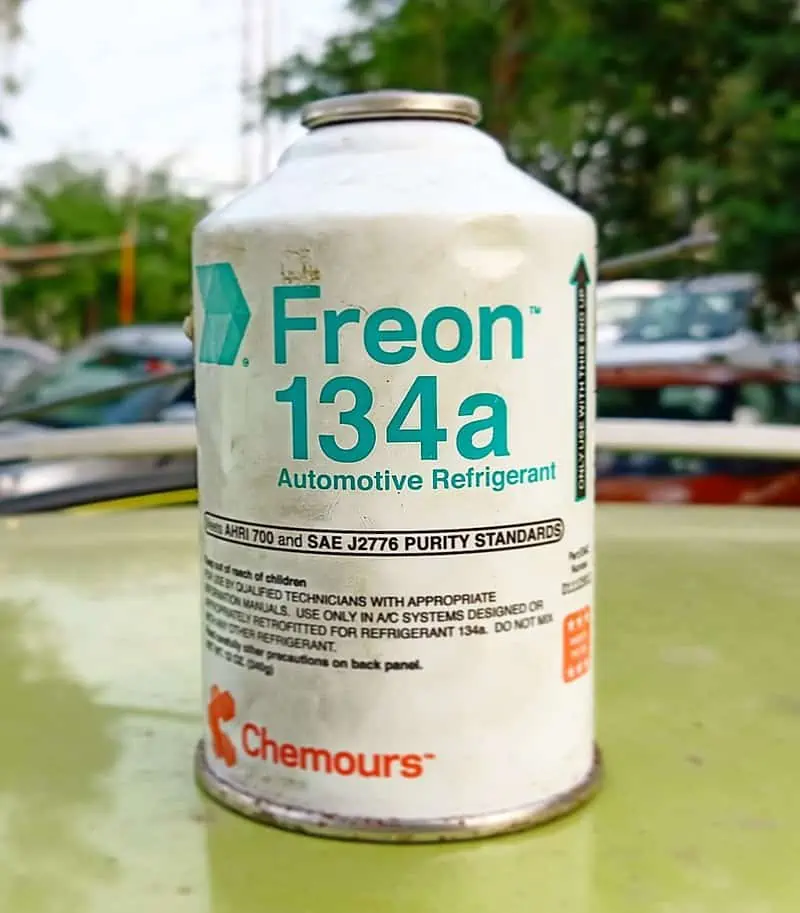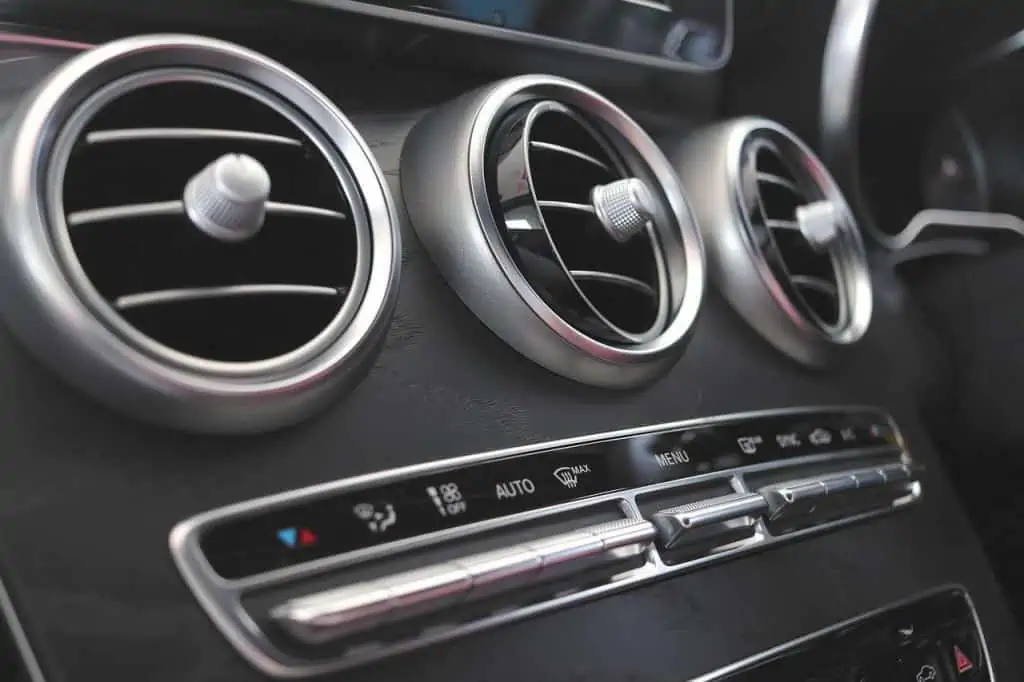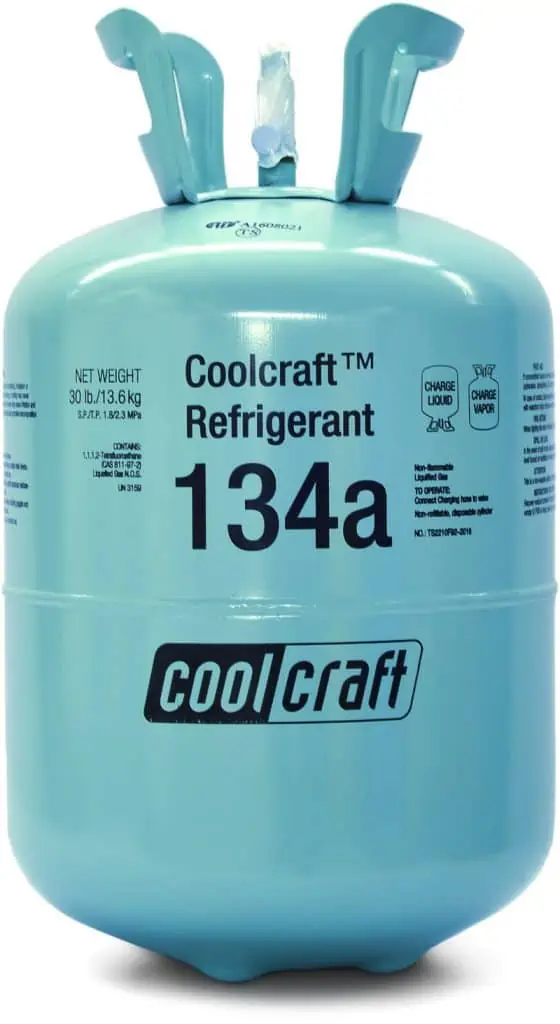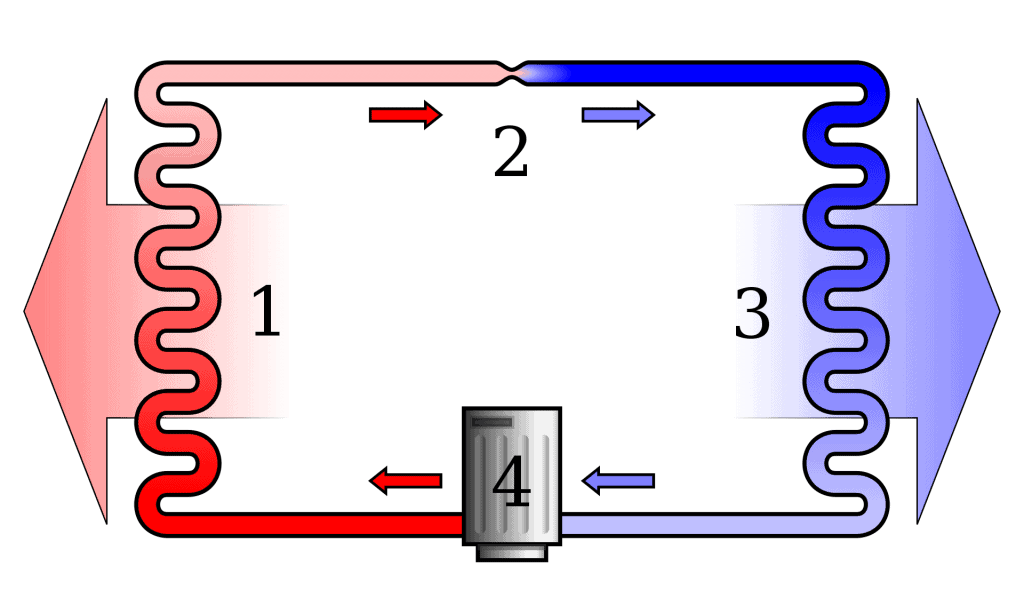Why is it vital to be aware of the typical vehicle’s low-freon symptoms? Freon is essential to the operation of the air conditioning system in your vehicle, therefore you need to be aware of these signs. A refrigerant (Freon) is primarily required for the air conditioning system in your vehicle to function.
What causes this air conditioning to occur? A compressor within the air conditioner compresses the refrigerant, raising its temperature and pressure. The temperature of the hot Freon is then lowered and made to flow through the AC unit’s coils, converting it into a liquid.
After passing through an expansion valve, where it evaporates and becomes a cold gas, the liquid Freon continues to flow. The Freon then circulates through a set of coils in this configuration, absorbing heat from your vehicle and cooling the inside. You must be aware of how to determine whether a car’s Freon levels are low because Freon is an essential component of the air conditioning system.
In warmer regions, driving without air conditioning is awful. Therefore, it is important to learn how to identify whether the air conditioning in your car has low amounts of freon and what to do about it.
You race to your vehicle in a hurry on a hot summer day in the hopes of finding some comfort. Nothing is worse in these circumstances than a car air conditioner that isn’t functioning properly. Sometimes the problems are simply warning indications that the air conditioner in your vehicle requires Freon.
It could be time for a recharge if the clutch isn’t engaging or the air isn’t blowing cold. Leaks may also be the source of low Freon; you may identify them by doing a visual inspection, checking the gauges, or looking through the sight glass in systems that have a sight glass.
In this post, we look at several indications that it’s time to recharge the air conditioner. We also demonstrate how to restore the system’s functionality. In addition, we provide a repair cost estimate so you know what to budget for.
Freon for Cars: What Is It?
Because they include chlorine, fluorine, and carbon, freons are often referred to as halogenated hydrocarbons. It is utilized in your car’s air conditioning system so that, even when you are traveling on a hot day, you will get a cooling impact inside the vehicle.
Regassing the air conditioning by Mike Peel / CC BY-SA 4.0. You can recharge your AC unit yourself if you know how to change the freon in your car. It would be best for you to let qualified specialists recharge your AC, though. This is because a professional is better suited to address leaks before recharging the AC. After all, leaks are frequently to blame for low Freon levels.
Chlorofluorocarbons, or CFCs, were present in the initial freons that were sold, which contributed to the ozone layer’s depletion. Since then, several businesses have investigated inventive methods to make freon refrigerants devoid of substances that harm the ozone layer of our planet.
The hydrofluorocarbons, or HFCs, that make up the new freon varieties don’t deplete the ozone layer.
Freon refrigerants have a variety of benefits that you might obtain from utilizing them in your vehicle.
- It aids in maintaining a cool and pleasant inside temperature for everyone traveling in that specific car.
- Since R-134a reduces its boiling point, it performs well in conditions of intense heat. As a result, it aids in increasing the effectiveness of the cooling effects in hot weather.
- Because they don’t include CFCs or other dangerous materials, Freons are safe for both humans and animals.
- Freons have a big impact on lowering greenhouse gas emissions, but further study is still needed.
What Kinds of Freons are Used In Your Car?
The most used kind of freon is R-134a, often known as HFC or HCFC since it includes hydrogen, chlorine, and fluorine. This kind of Freon is used in the vast majority of vehicles nowadays.
Due to ozone depletion, R-12 was previously widely utilized but has now been phased out in favor of R-134a due to its superior environmental impacts. This is still occasionally referred to as “Cars, Trucks, & Motorcycles” (CTM).
Another version you can see is a mixture called R-500, which is composed of two parts ethane and one part propane (C₃H₈ + C₆H₄ = C₃H₈C₆H₄). Where it is accessible, you can use it in place of R-12 or R-134a.
Finally, new refrigerants are always being developed, so your car could utilize one that isn’t listed here.
Consult a professional to learn what kind of freon your vehicle uses if you’re unsure. The label or tag that identifies the type of freon in your vehicle will probably need to be accessed to be found by the technician.
Which Ones Are the Common Low Freon Symptoms In a Car?
The air conditioning system in your vehicle won’t work correctly if the Freon level lowers. But things don’t just stop there. Since the amount of Freon is too low for the compressor to pressurize, the AC clutch won’t engage. But that is a signal that might not be immediately apparent.
The good news is that your vehicle will also display additional signs of low refrigerant. Here are a few examples.
1. Refrigerant Loss While Driving
If the cooling temperature from the AC vents in your car suddenly drops while you’re driving, there may have been a leak of some of the pressurized Freon in the seals, hose, or fittings.
Freon 134a refrigerant for car AC by Suyash.dwivedi / CC BY-SA 4.0. The kind of freon that is most frequently used is R-134a, sometimes referred to as HFC or HCFC since it contains hydrogen, chlorine, and fluorine. Nowadays, the great majority of cars utilize this type of Freon.
You will then see emissions from the leaky region that resembles a white cloud. In certain cases, the compressor may also hiss, and the inside of the car may smell like refrigerant.
2. Visible Leaks
Visible freon leaks are a typical sign that your car’s freon levels are low. In its liquid condition, freon often resembles grease but is lighter since it contains some oil to lubricate the compressor. Check the various parts of your car’s AC system if you think there could be a Freon leak.
Examine the fittings that connect to the compressor, the front shaft, the accumulator, the condenser, the service ports, the pressure lines, and the service ports. You may have a Freon leak if you see something on these components, such as a film or stream of liquid.
To be certain, remove this film or stream, and if it reappears, there’s a good likelihood your vehicle has a Freon leak and its Freon levels are low.
3. The Reduced Gauge Readings
Get the AC pressure readings for the vehicle as one method of checking the freon level in a car. Once you understand how to use gauges to check the freon in a car, you can perform this. An AC manifold gauge should first be connected to the high- and low-service ports.
By utilizing a quick-release fitting to connect the red gauge hose to the high-side service port, you can make sure the gauge is securely fastened. Make that the blue gauge hose is attached to the low-side service port.
When the car’s engine and air conditioning are off, turn on the red and blue gauges’ dials to acquire the right readings. You should measure the pressure at 80 to 105 psi.
The high side should register between 200 and 350 psi whereas the low side should register between 25 and 35 psi when you take the same measurements with the AC set to the maximum setting. Your car’s Freon levels are low if the readings are lower than this.
4. The Sight Glass
Checking the sight glass of your vehicle might also reveal whether it has enough refrigerant (if your vehicle comes with one). This part enables the observer to track Freon’s progress via the high-pressure line.
You will observe a clear fluid running through the line when the Freon level is ideal. You can see bubbles when there is not enough freon present. There is no Freon in your vehicle if there is no movement.
5. No Cold Air Is Blowing from the AC
Depending on whether you have the AC set to blast hot air or cold, a functioning vehicle AC unit with ideal Freon levels will do so.
While the AC blows warm or hot air when it is set to blow cold air, this is one of the more visible symptoms that the Freon levels in your vehicle are low. This happens because the system is pressurized and circulated by little or no Freon.
While you’re driving, if the cooling temperature coming from your car’s AC vents suddenly lowers, there may have been a pressurized Freon leak in the seals, hose, or fittings.
6. Failures of the Clutch to Engage
The compressor in your vehicle builds pressure because of the A/C clutch. When you switch on the air conditioning in your vehicle, you should hear a clicking sound. The sound that is produced when the AC clutch engages is that sound.
The A/C clutch measures the presence of Freon. The inference is that the Freon is far too low when it is unable to engage. Additionally, it is a sign that there is insufficient refrigerant in the vehicle for the compressor to compress.
7. Components with Corrosion or Cracks
Last but not least, examine how severely rusted or cracked certain components are close to where the Freon enters your system if everything else fails and none of these other symptoms appear appropriate for your circumstance (for example, the evaporator).
It’s preferable to discover these issues early because damaged parts will almost certainly leak Freon and need to be replaced.
Take your vehicle to a repair right away if you see any of these warning signs of low Freon! Freon levels that are appropriate will not only improve your air conditioner’s performance but also keep you and other drivers safe by lowering the risk of an accident caused by your air conditioner.
8. Ice Buildup Near the Compressor
Ice accumulating around the AC compressor ranks eighth on our list of indicators that your vehicle needs more Freon. Condensation can lead to frost and even ice formation where it shouldn’t be if there isn’t enough coolant to keep things functioning properly. When you are inspecting the undercarriage, keep an eye out for this indication.
Why Do You Need Freon for Your Car?
For your air conditioning system to function properly, a continuous flow cooling system, or CFC, must circulate coolant throughout the whole car. You have a fan blowing hot air if you don’t first circulate the coolant through your engine. Furthermore, you should avoid having hot air blowing in your face.
There are now two major categories of CFC systems: the earlier, less effective version with a single cooling fan and the more recent type with an additional auxiliary electric cooling fan in addition to the primary engine-driven cooling fan. Unfortunately, both systems share the same flaw: they frequently fail to adequately cool the air under extreme heat.
How Does Freon Function In Your Car?
By eliminating heat and moisture, the Freon in the air conditioning system cools the air. The majority of the hydrocarbon gas that makes up the compressed and purified Freon used in the air conditioning system is methane, ethane, and propane.
An air conditioner functions as a sizable heat exchanger. In essence, chilled Freon gas is pushed over a lengthy coil of pipe while air passes over it. The pipe absorbs the cooling force of the freon gas as it runs over it.
Then, this pipe is situated within a frigid chamber. The heat that the cold Freon gas has released is subsequently transferred back into the air-conditioned area.
Why Does a Car Need to Recharge on Freon?
Let’s examine more closely what occurs when your air conditioner is turned on during the summer. When the refrigerant flows through an expansion valve, its pressure quickly drops from 200 psi to 30 psi. However, the fan further lowers pressure to around 10 psi when the refrigerant exits the valve and enters your area, which warms it up once again.
To avoid levels dropping to the point where they can permanently destroy the AC system, drivers should be aware of the warning signs that the Freon is running low.
The condenser cannot properly dissipate more heat when a second electric cooling fan is added, forcing more air through the device. The air that is flowing more quickly rises above the evaporator in your dash and enters the HVAC plenum of your car.
Here, it combines with colder air that is entering your vehicle from the front grill from the outside. This leads to additional heated air flowing throughout your cabin, which is a bigger issue. The temperature in your plenum is higher than it was in your condenser, which just makes the issues worse.
The air coming out of your HVAC vents might be at various temperatures, which is explained by all of this. It depends on your location, the hour of the day, and how quickly the wind is blowing outdoors. This takes us full circle to the topic we started with: Does your vehicle require a freon recharge?
Guess what, though? If your AC system isn’t cooling effectively because too much heat is being produced by excessive auxiliary electric fan cooling, it could work. As a result, it deprives your primary radiator fan of some of its cooling power.
How Can I Check My Car’s Freon?
To make sure the freon level in your car’s air conditioning system is correct, you must check it from time to time. If not, you will either need to replace your AC entirely or add additional Freon.
We’ll walk you through the process of determining your freon level.
The following tools are a must-have:
- The Phillips screwdriver
- The spanners or a socket set
- A Ratchet
- A measuring jug or cup
- A Funnel
Below is a step-by-step Instruction
- Open the hood of your vehicle and look for the AC compressor first. It will be on one of the engine bay’s sides and resemble the following:
- Once you’ve located it, unscrew the three screws holding the lid in place using the Phillips head screwdriver. Make sure none of these screws are lost at any cost! The bolt holding the compressor in place may then be removed using a socket set or a wrench. After that, you’ll be able to remove the compressor lid.
- The compressor is now visible, so you can inspect the freon tanks. On either side of the compressor, there will be two of these. The tanks will be topped with a pressure valve and filled with colorless gas. Each tank has a gauge with indications from 0 to 300 psi on the side.
You must ascertain the current reading and contrast it with the suggested values stated below to determine the level of freon in your car:
- Your vehicle does not require any extra Freon if the level is at or above 150 psi.
- If the amount of Freon in your vehicle is more than 50 psi but lower than 150 psi, you will need to add around half a can of Freon.
- You must add a whole can of Freon if the level in your vehicle is lower than 50 psi.
Several companies sell freon refrigerants, but you should only rely on those with stellar testimonials. Consult your vehicle dealer before deciding the kind of freon to use in your car’s air conditioning system.
It’s crucial to remember that you must have your car’s AC system professionally refilled if the Freon level is lower than 50 psi. It’s because mistakenly adding Freon yourself may be deadly.
How Can I Add Freon to a Car’s Air Conditioning System?
Once it has been established that an air conditioner has run out of gas, recharging is required to preserve appropriate operation. Consider taking the following steps to achieve this:
Step 1: Identify the System or Circuit’s Inputs
Locate the circuit inlets first, which are often two pipes (one high-pressure and one low-pressure) with plugs that need to be unscrewed on each.
The low-pressure pipe is broader than the high-pressure pipe, which is the smaller of the two pipes. It is advised to refer to the instruction manual for extra details if they are not immediately apparent.
Step 2: Link the Device to the Circuit
The low and high-pressure ports of the pressure regulator should be connected with the hoses. When the device is first used, the pressure gauge should initially display values between 8 and 10 bar.
However, make sure all other hoses are securely closed before joining the circuit.
Step 3: Unlock the Conduits
The next step is to open the hoses so that air may pass through them after making sure the connection is secure. One of these tasks should be completed at a time, not both at once.
Just before the marker reaches a few points above the ground, open the hoses. As the cannon is unplugged from the pipeline, it must be kept from rupturing and releasing gas through the hoses.
Step 4: Regain the Vacuum and the Gas
During this process, the gas residue is recovered, and the region is then cleaned. Opening the low and high-pressure ports of the gadget and pushing the green button are the only steps needed for this straightforward operation.
The green valve on the side of the tank must be opened to retrieve the gas after self-cleaning. The suction will continue to operate for a total of 20 minutes after this process is finished.
Step 5: Examine the Pressure
Verify that the equipment’s low and high-pressure gauges are both adjusted to -1 bar. The gas leak can still be there if the gauge slowly begins to increase.
If this is the case, halt the operation and examine the circuit to identify the troubleshooting steps necessary to carry out a successful gas recharge.
Step 6: Do a Freon Recharge
Continue with the gas recharging after closing the circuit entirely. This is started by holding down the red button on the machine for a time.
Always keep on hand the precise quantity required for the car; a label on the engine will display this quantity.
1) condensing coil, 2) expansion valve, 3) evaporator coil, 4) compressor. The diagram’s arrows are intended to represent the movement of air and coolant; they do not correlate to the movement of heat, which in the system shown is (typically) from right to left.
Step 7: Examine If the A/C Is Functioning Correctly
Once the system has been fully recharged, shut the valves and test the air conditioner to ensure it is operating correctly.
You should also block the hose channels. The cooling system must be activated and set to its highest setting. Strong airflow and a cool environment are signs that the work has been finished.
Is Freon Containing Any Hazardous Chemicals?
The answer is no since halogenated hydrocarbons, which are included in all air conditioning refrigerants, help to reduce cabin temperature even on hot days. This does not imply, though, that you may pick any brand of freon at random.
For the best chance of future cooling system issues, it would be preferable if the manufacturer of your vehicle recommended the sort of freons to be used in it.
Several manufacturers sell freon refrigerants, but you should only trust those with excellent reviews. When choosing the type of freon to use in your vehicle’s air conditioning system, you should consult your car dealer.
This will make it simpler to maintain optimal cooling effects throughout the year while also keeping everyone in the vehicle secure.
How Much Does a Recharge of Freon Cost?
When estimating the cost of the Freon in the vehicle, there are a few things to take into account. The ultimate cost depends on the kind of Freon used, how much is required, and where it is obtained.
The R-134a Freon is the first option, and it can be found in many car supply stores. R-134a costs vary depending on how much you buy but normally run between $15 and $25 per gallon. Per gallon, larger volumes are often less expensive.
For vehicles that employ CO2 refrigerant-based HVAC systems, there is also R-1234yf. A gallon of this kind of Freon typically costs between $40 and $60.
It is crucial to keep in mind that not all retailers offer both varieties of Freon, so before visiting, contact to confirm that they do.
Be mindful that certain auto supply shops will only sell Freon to qualified specialists. You might need to go for a specialized store or do an internet order if you’re not an expert.
There are several things to take into account when calculating the cost of a car’s freon. But with a little bit of investigation, you can quickly locate the ideal Freon at a cost that suits your needs.
How Frequently Does a Car Need to Get Its Freon Replaced?
You won’t ever need to replace the Freon if your air conditioning system is in excellent condition. You won’t need to refill Freon until there is a problem because it does not deplete as gas or oil does.
If there is a leak in your AC system, you may need to replace the Freon because if the levels go too low, your AC system might malfunction or stop working altogether.
The performance of the air conditioner is unaffected by the loss of trace quantities of Freon in vehicles where the AC units were not designed to have the Freon replenished. However, various factors affect how often Freon has to be replaced.
similar to when the air conditioner stops blowing as effectively. Additionally, since there is no required maintenance schedule, you can change the Freon in your vehicle once a year.
Is Running an AC With Low Freon Bad?
It is, indeed. ideally over the long term. Even with low Freon levels, your car’s AC system will still work. However, its performance will be at most mediocre. However, if you don’t address the problem right away, there’s a chance that it could worsen to the point where your AC unit will sustain significant damage.
A DuPont refrigerant for cars by Stephanie~commonswiki / CC BY-SA 3.0. While the quantities of Freon in a vehicle’s air conditioning system will eventually run out, unlike gasoline, Freon does not need to be regularly topped off. If the engine is functioning properly, the Freon in your car’s air conditioning system won’t need to be replaced for a very long time.
Should I Recharge My AC On My Own?
If you know how to change the freon in your vehicle, you can recharge your AC unit yourself. However, it would be advisable for you to allow trained professionals to recharge your AC. This is because leaks are typically to blame for low Freon levels, and a professional is better equipped to fix these leaks before recharging the AC.
You won’t have the necessary training to manage refrigerants unless you are a certified technician, and you could not be aware of the ideal amount to restore into the AC unit. Even if there are several guides on how to recharge your car’s air conditioning yourself, use a qualified professional instead.
Which Freon Is Best for a Car?
The same cannot be said for all freons. You must know the type of your vehicle to get the appropriate freon for it. Because there are many freons for various vehicles, once you know that, you can choose which freon is ideal.
As a result, before purchasing a freon appropriate for your vehicle model, you must conduct a thorough study. Asking a mechanic will be a quick route to take.
Can a Vehicle Lose Freon Without Having a Leak?
The AC system does not exhaust or use Freon (refrigerant). Freon is constantly circulating throughout the system, so if you see levels getting low, there probably is a leak.
The engine of your vehicle houses the air conditioning system, a hot, unclean area where harm might result. You will start to lose Freon if any of the AC system’s piping or hoses crack.
What Occurs If a Car Has Too Much Freon In It?
The compressor in a vehicle’s air conditioning system could malfunction if it has too much freon. Your car won’t operate as smoothly as normal and can even have trouble starting when there is too much refrigerant in the system.
You must do a pressure check of the high and low-pressure lines to determine whether there is too much Freon in the vehicle’s air conditioning system.
The Conclusion
It could be time to replace the Freon if the AC system in your car has started to malfunction or has ceased functioning altogether. Utilizing high and low pressure, air conditioning systems convert the gas (Freon) into a liquid.
The system’s refrigerant has been running constantly, traveling through both the high- and low-pressure sides. If there are sufficient amounts of Freon flowing through the AC system, it will only be able to discharge cool air.
The Freon levels in a vehicle’s air conditioning system will deplete with time, but unlike petrol, Freon does not require routine topping off. The Freon in your car’s air conditioning system won’t need to be replenished for a long time if the engine is running well.
However, system leaks might occur and lower Freon levels. If there is not enough refrigerant, Freon leaks might result in a decline in AC pressure, and your AC may cease to function entirely.
Drivers should be aware of the warning indications that the Freon is running low to prevent the levels from falling to the point where they might harm the AC system permanently.


Nyangano Maurice specializes in vehicle troubleshooting and has more than 10 years of experience in the automobile industry. Over many years of experience as a car mechanic, he has acquired a broad range of skills, including engine repair, brake systems, electrical systems, and more. He frequently hosts community workshops and training programs to help motor vehicle owners understand their vehicles better.
